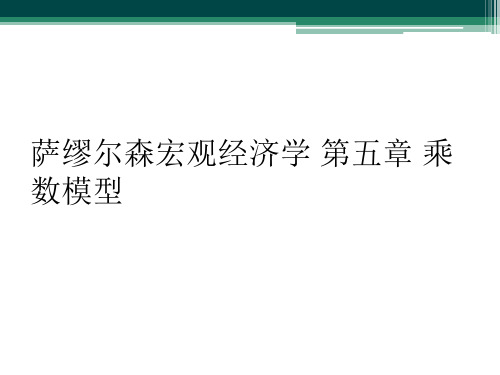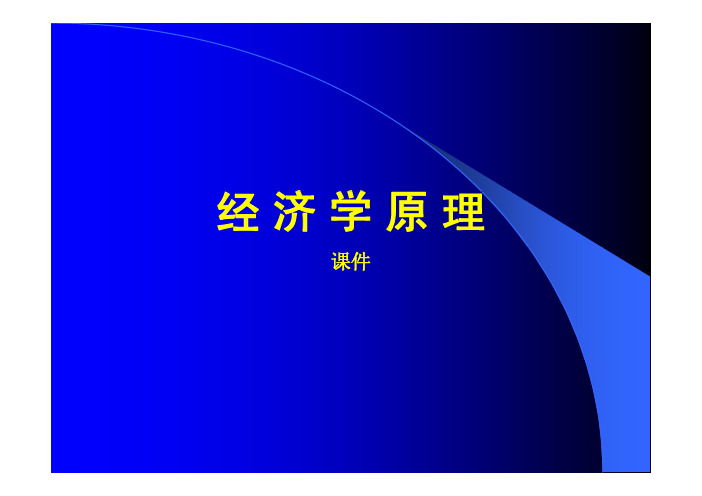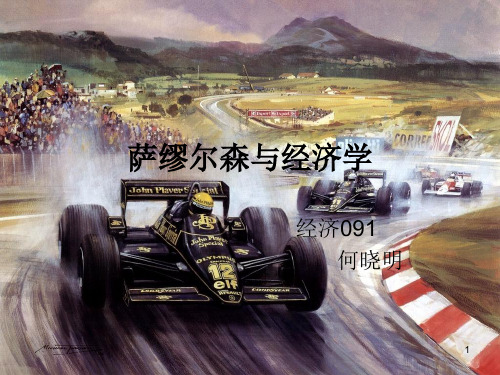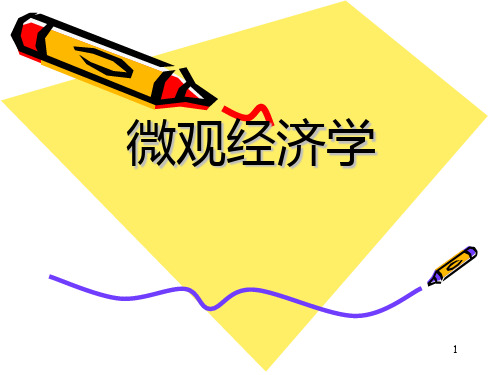萨缪尔森《经济学》课件
萨缪尔森宏观经济学 第五章 乘数模型

衡产出; 3、征税对总需求的影响 4、数值例子。
5、三部门下均衡状态下国民收入的决定因素:
❖ 当其他条件不变时,边际消费倾向越大,均 衡收入水平越高;
❖ 当其他条件不变时,投资、政府购买和转移 支付越大,均衡收入水平越高;
❖ 当其他条件不变时,所得税税率越低,均衡 收入水平越高。
萨缪尔森宏观经济学 第五章 乘 数模型
第四章(2)乘数模型
本节核心:支出对产出波动的传导机制
❖ 基本乘数模型
储蓄与投资对产出的决定作用 乘数理论 展望乘数模型
❖ 乘数模型中的财政政策
财政政策怎样影响产出 财政政策乘数 现实中的乘数
一、基本乘数模型
❖ 分析逻辑:
储蓄投资法
均衡产出的决定
❖ 核心概念:
❖ 乘数模型经由消费、投资和其他变量的互动, 来揭示总需求的决定过程。也就是说,乘数 模型就是总需求—总供给模型的一个特例。
(a) 乘数模型 (b) AS-AD方法
E
总 支
C+I
出
C
潜在GDP C+I C
45° 0
Q
QP
实际GDPGຫໍສະໝຸດ P价AD格
水
平 AS
潜在GDP
AS E
AD
0
Q 实际GDP
GDP
但是税收乘数小于支出乘数,小的幅度为一 个MPC因子,即:
税收乘数=MPC × 支出乘数 ❖ 税收乘数小于政府购买的支出乘数的原因。 3、乘数模型与商业周期
(三)现实中的乘数
❖ 本章中的乘数仅仅是最简化的模型,没有考虑到 宏观经济中其他因素的影响。
❖ 货币因素,简化模型没有考虑货币体系的作用。 但由于乘数的作用,价格、利率、信贷等变量会 发生变动,结果又会反过来影响乘数的作用。
萨缪尔森《经济学》第1章

经济学(economics)研究的是一个社会如何利用稀缺 资源生产有价值的商品,并将它们在不同的人中间分配。
稀缺(scarcity):
两大核心思想
效率(efficiency):
现代意义上的宏观经济学(macroeconomics)出现的标志是 1935年约翰·梅纳德·凯恩斯发表的革命性巨著《就业、利息与 货币通论》。
※为什么证券业的人比老师赚的钱多? 金融危机对中国经济的影响。 ……
规范经济学(normative economics)试图描述世界应该 如何运行的问题。涉及伦理信条和价值判断. ※金融危机下政府应该出台相应的刺激经济的政策 吗? 穷人应该得到政府的特殊照顾吗? ……
Байду номын сангаас 市场经济、指令经济和混合经济
第1章 经济学核心概念
保罗•萨缪尔森
本章主要内容与结构
A. 导 言 ❖ 撞钟为谁 ❖ 稀缺与效率:经济学的双重主题 ❖ 微观经济学与宏观经济学 ❖ 经济学的逻辑 ❖ 热切的心情,冷静的头脑
B. 经济组织的三个经济问题 ❖ 市场经济、指令经济和混合经济
C. 社会的技术可能性 ❖ 投入和产出 ❖ 生产可能性边界
产出更能令人满意。 3. 为谁生产和分配这些产出。
一个生产活动的例子
可能状态
A B C D E F
奶油 (百万磅)
0 1 2 3 4 5
大炮 (千门)
15 14 12 9 5 0
生产可能状态的说明
生产的可能状态是指,给 定投入时最大的可能产量。 可能状态
否则,结果将不是唯一的。 A
B
C
D
E
F
机会成本
机会成本(opportunity cost) 是指,选择一种东西意味着要 放弃其他一些东西。
经济学基础完整 ppt课件

所以姚明是最聪明的,他没有让机会白白遛走,他抓住了机遇。虽然姚明有时 候也感叹:“我现在也就是一个蓝领,天天干的都是力气活!”虽然他也想 上大学,但是它可能会说他“上不起大学”。这并不是说他付不起学费,而 是指他不原意放弃上大学所能赚到的高额收入。证实一种东西的机会成本是 为了得到这种东西所放弃的东西。经济学家会这样理解:由于个人上大学的 机会成本达到了足够高的程度,以至于上大学反而得不偿失。
欲望的无限性 资源的稀缺性
12
矛盾
经济学产生
欲望 人们为了满足生理和心理上的需要而产生的 渴求和愿望
特点 多层次:需求的多样性 无限性:欲望是无穷尽的(一种欲望得到满足后,甚
至未得已满足时,欲望就产生了。)
13
资源的稀缺性
一、什么是资源
用来满足人类欲望的物品可以分为:
1、自由取用物品:价格为零供给为无穷大。
9
目录
第一节 经济学的研究对象 第二节 经济学的研究内容
第三节 经济学的研究方法
10
第一节 经济学的研究对象
一 经济学的定义 二 经济学产生的前提 三 选择资源与配置 四 资源利用与经济制度 五 经济学十大规律
11
第一节 经济学的研究对象
一、 经济学的定义
具体来讲研究各种稀缺资源如何被配置和利用的科学 。--欲望的无限性;资源的稀缺性,以有限的资源满 足无限的欲望。
笨,没有学问无颜见爹娘 ……” • “太阳当空照,花儿对我笑,小鸟说早早早……”
4
你是否有经济头脑??
王师傅是卖鞋的,一双鞋进价30元甩 卖20元,顾客来卖鞋给了张50,王师 傅没有零钱,于是找邻居换了50元。 事后邻居发现钱是假的,王师傅又陪 了邻居50。
经济学原理1经济学基础知识

经济学原理课件教材●《经济学》萨缪尔森、诺德豪斯著第16版华夏出版社社●主要参考教材:《西方经济学》高鸿业主编中国人民大学出版社第二版第版第一章经济学基础知识●A介绍1为什么学习经济学?●1.为什么学习经济学?每个人都是经济行为的主体,时刻参与经济活动面对经济决策的选择●2、经济学是什么?经济学是研究如何利用稀缺的资源进行有效生产并将产品和劳务进行有效分配的科学。
分配既包括同一时期的分配,也包括同一物品不同时间之间的分配。
时间之间的分配2、为什么会产生经济学?●资源的稀缺性:资源不仅指自然资源,资本资源,也包括时间资源,人力资源以及信息资源。
源也包括时间资源人力资源以及信息资源经济品:稀缺物品或有限物品●人们欲望的无限性●效率:在不会使其他人的情况变坏的前提条件下,一项经济活动如果不再有可能增进任何人下一项经济活动如果不再有可能增进任何人的经济福利,那么该经济活动就是有效的。
效率的两层含义:经济活动是增加福利的(有效果),但也是有成本的。
效率考虑的是成本与收益的衡量2、经济学本质●选择行为:虽然经济行为主体在即定的约束条件下,通过不同的行为方式实现某种目标,但资源的稀缺性和对效率的追求决定了经济人的选择的必然性。
选择意味着自由和放弃(机会成本的概念)●经济学的本质33.微观经济学与宏观经济学规范经济学与实证经济学●微观经济学:研究个体的经济行为,包括企业、家庭和个人。
(亚当.斯密)括企业家庭和个人(亚当斯密)●宏观经济学:研究经济的总体运行,就业,通货膨胀与增长。
(凯恩斯)●实证与规范经济学:是什么与应该是什么,经济学更多的是实证分析实证与规范的渗透与联系规范性判断●实证与规范的渗透与联系:规范性判断是建立在实证分析的基础上的。
结构入门:经济学原理理论基础:微观经济学、宏观经济学理论基础微观经济学宏观经济学分析方法:计量经济学、数理经济学应用学科产业组织国际经济学(国际贸易与应用学科:产业组织、国际经济学(国际贸易与国际金融)、公共经济学(公共财政)、货币金融学、制度经济学、农业经济学、货币金融学制度经济学农业经济学发展经济学、劳动经济学、环境经济学、卫生经济学等方法实证(Positive)研究:研究世界是怎样运行的。
萨缪尔森经济学课件 (27)

McGraw-Hill/Irwin
© 2005 The McGraw-Hill Companies, Inc. All Rights reserved.
TM – 10
Chapter 30 Table 30-1
McGraw-Hill/Irwin
© 2005 The McGraw-Hill Companies, Inc. All Rights reserved.
TM – 4
Chapter 30 Figure 30-4
The Foreign Exchange Value of the Dollar
McGraw-Hill/Irwin
© 2005 The McGraw-Hill Companies, Inc. All Rights reserved.
TM – 5
TM – 11
Chapter 30 Table 30-2
McGraw-Hill/Irwin
© 2005 The McGraw-Hill Companies, Inc. All Rights reserved.
TM – 12
Chapter 30 Table 30-3
Me McGraw-Hill Companies, Inc. All Rights reserved.
TM – 1
Chapter 30 Figure 30-1
U.S. Net Exports Turned Sharply Negative in 1980s
McGraw-Hill/Irwin
© 2005 The McGraw-Hill Companies, Inc. All Rights reserved.
McGraw-Hill/Irwin
萨缪尔森经济学课件 (28)

Chapter 31 Figure 31-5
Okun’s Law Illustrated, 1955-2002
McGraw-Hill/Irwin
© 2005 The McGraw-Hill Companies, Inc. All Rights reserved.
TM – 6
Chapter 31 Figure 31-6
TM – 3
Chapter 31 Figure 31-3
AS Is Relatively Flat in the Short Run but Turns Vertical in the Long Run
McGraw-Hill/Irwin
© 2005 The McGraw-Hill Companies, Inc. All Rights reserved.
Distribution of Unemployment by Reason, 1982 and 2000
McGraw-Hill/Irwin
© 2005 The McGraw-Hill Companies, Inc. All Rights reserved.
TM – 9
Chapter 31 Figure来自31-9McGraw-Hill/Irwin
© 2005 The McGraw-Hill Companies, Inc. All Rights reserved.
TM – 11
Chapter 31 Table 31-1
McGraw-Hill/Irwin
© 2005 The McGraw-Hill Companies, Inc. All Rights reserved.
Inflexible Wage Can Lead to Involuntary Unemployment
经济学 萨缪尔森ppt课件

中获得启示和教益。
9
保罗·萨缪尔森与诺贝尔经济学奖
• 萨缪尔森曾在年轻时代Biblioteka 慨经济学家无法获得诺贝尔经济学奖,因为
在那之前,诺贝尔经济学奖还未设立。1968年,诺贝尔奖设立了经济 学奖,萨缪尔森成为第一个获得诺贝尔经济学奖的美国经济学家。
到美国预算局,为美国政府出谋划策。
•
肯尼迪是美国第一位旗帜鲜明地奉行凯恩斯主义的总
统。肯尼迪采纳了萨缪尔森的建议,实行了著名的“肯尼
迪减税”政策,减税增加了消费支出,扩大了总需求,并
增加了经济的生产和就业。实际上当肯尼迪提出的减税最
终在1964年实施时,它促成了一个经济高增长的时期。
萨缪尔森也成为白宫中不可缺少的高参。
7
保罗·萨缪尔森成就之二:帮助在经济
困境中上台的肯尼迪政府制定了著名的“肯尼迪减
税方案”
• 1961年1月,肯尼迪就任总统时所发表的第一个国情咨文
中就悲观地宣布:“目前的经济状况是令人不安的。我们 是在经历7个月的衰退、3年半的萧条、7年的经济增长速 度降低、9年的农业收入下降之后就任的”。
•
1953年,当《经济学》第三版发行时,萨缪尔森来
5
保罗·萨缪尔森成就之一:将数学引 进了经济学
• 1931年,保罗·萨缪尔森考入芝加哥大学,专修经济学, 年仅十五岁。
•
此时的经济学发展,就如萨缪尔森在1985年2月的一
次演讲时所说:“1932年我开始在芝加哥大学攻读经济学
时,经济学还只是文字的经济学。”数字还没有加入到经
济学科当中来。
•
萨缪尔森接着说道:“在旧式的经济学中,处处充斥
3
《经济学》
• 以四十多种语言在全球销售超过四百万册,是全 世界最畅销的教科书,影响了整整一代人。 也正是他的这本著作,将西方经济学理论第一 次系统地带进中国,并使这种思考方式和视野在 中国落地生根。
萨缪尔森《经济学》第1章

经济学
宏观经济学
亚当· 斯密通常被认为是微观经济学 (microeconomics)的创始人.
微观经济学研究对象
单 个 实 体 的 市 场 行 为
企 业 行 为
家 庭 行 为
现代意义上的宏观经济学(macroeconomics)出现的标志是1935 年约翰· 梅纳德· 凯恩斯发表的革命性巨著《就业、利息与货币 通论》。
后此谬误或称因果谬误(the post hoc fallacy):根据 发生于其后者,得出是其结果的结论。 误用“其他情况保持不变”条件(failure to hold other things constant):仅仅依据假定“其他情况保 持不变”的条件得出结论。 当你分析一个变量对于经济体系的影响时,一定 要保持其他条件不变 合成谬误(the fallacy of composition):将局部正确 的结论推向整体。
某些特殊的图
时间序列图 表示某一特定变量如何随时间变化而变动。例 如本书第一张图。 散点图 散点图是为了 描绘出变量在不同年 份的组合,一个重要 的例子就是消费函数。 多曲线图 在同一图中做出两条曲线从而得到一个多曲线图, 这通常是非常有用的。最重要的例子是第3章的供给和需求 图。
在绘制和运用曲线图时,我们要注意以下3点:
◇ ◇◇◇◇ 经多 观哈 平 约 格 济恩 点尔 狄 瑟 里 学布 》 克 夫 高 》什 范 、 斯利 里 、 安鲁蒂曼 费 《宾格昆 希 微费利《 尔 观尔茨经 、 经德《济 斯 济《经学 塔 学微济原 兹 :观学理 《 现经》》 宏 代济 观 学 》 • •
• • •
•
参 考 书 目
经济研究与文献查阅
曲线的斜率
54微观经济学萨缪尔森PPT课件

包括姓名,QQ号码,邮箱,手机号码
4
• 使用教材:
• 萨缪尔森,微观经济学,人民邮电出版社 , 2009年第18版
• 参考书籍:
• 曼昆,《经济学原理——微观经济分册》,北京 大学出版社,2006版
• 高鸿业,《西方经济学微观部分》,中国人民 大学出版社,2007版
9
经济学产生的基础 • 资源的稀缺性
•
选择
• 欲望的无限性
10
人的欲望能否满足?
• 终日奔波只为饥 方才一饱便思衣 • 衣食两般皆俱足 又想娇容美貌妻 • 取得美妻生下子 恨无天地少根基 • 买到田园多广阔 出入无船少马骑 • 槽头扣了骡和马 叹无官职被人欺 • 县丞主簿还嫌小 又要朝中挂紫衣 • 作了皇帝求仙术 更想登天跨鹤飞 • 若要世人心里足 除是南柯一梦西
19
社会的技术可能性用的物
品或劳务。 土地 劳动 资本
• 产出 生产过程中创造的各种有用的物品
或劳务,它们可以用于消费或用于进一 步生产
20
生产可能性曲线 (production possibility curve)
• 又称生产可能性边界PPF(production possibility frontier):
• 约翰·戈登,伟大的博弈,中信出版社, 2005年
• 王春永,博弈论的诡计,中国发展出版 社,2007年
6
• 论坛等: • 人大经济论坛
/bbs/ • 经济学家 • /
• 上课时间?
7
第一章 经济学的基础知识
• 经济学的研究对象 • 经济组织的三个经济问题 • 社会的技术可能性 • 经济学的研究方法
8
经济学的研究对象
经济学PPT课件

然而,可实验性并不是科学必要条件。例如,一 般认为天文学不具有实验性。检验天文学理论假 设的经验证据不是来自实验环境,而是自然过程 提供的观察现象。地质学大陆板块漂移假说,也 难以用实验进行验证。
什么是科学?与信仰认识方式不同,科 学用实证方法观察和分析客观对象状态, 属性及其相互之间的关系。
科学本质特点是它的实证性,即解释对 象“是什么”的一种思维方式。
2019/11/2
18
实证科学特征之一:可证伪性
理论陈述必须在逻辑上有可能被经验证明是 不真实的。因而,在提出科学理论时,必须 同时说明或潜在包含你将放弃这一理论的条 件。
黄油 0 5 10 15 20
2019/11/2
6
生产可能性曲线(Production Possibility Curve,PPC)
大炮
a
k b
c h
d
o
2019/11/2
e 黄油
f
7
社会最大化生产点
产品 B
2019/11/2
在PPC上,为最大化生产点 在PPC内,生产能力未得到充分利用
产品A
包括以下三个方面的内容: 无限的欲望 稀缺的资源(经济问题的根源) 由上两者的矛盾所产生的选择问题 机会成本概念:指在作出某一项决策时所放弃的其他可供
选择的决策的最好得益
2019/11/2
5
生产大米和小麦的可能性表
表 1.1
生产组合 A B C D E
大炮 10 7.5 5 2.5 0
2019/11/2
10
循环流模型
经济行为的主体---企业和居民户
成本 生产要素
要素市场 收入
生产要时
- 1、下载文档前请自行甄别文档内容的完整性,平台不提供额外的编辑、内容补充、找答案等附加服务。
- 2、"仅部分预览"的文档,不可在线预览部分如存在完整性等问题,可反馈申请退款(可完整预览的文档不适用该条件!)。
- 3、如文档侵犯您的权益,请联系客服反馈,我们会尽快为您处理(人工客服工作时间:9:00-18:30)。
How markets solve the three economic problems
What goods and services will be produced is determined by the dollar votes of consumers in their daily purchase decisions. Firms are motivated by the desire to maximize profits (net revenues, or the difference between total sales and total costs). How things are produced is determined by the competition among different producers. The best way for producers to meet price competition and maximize profits is to keep costs at a minimum by adopting the most efficient methods of production. For whom things are produced – who is consuming, and how much – depends, in large part, on the supply and demand in the markets for factors of production. Factor markets determine wage rates, land rents interest rate, and profits.
A market is a mechanism by which buyers and sellers interact to determine the price and quantity of a good or service. A market economy is an elaborate mechanism for coordinating people, activities, and businesses through a system of prices and markets. In a market economy, no single individual or organization is responsible for production, consumption, distribution, and pricing.
The important thing for government is not to do things which individuals are doing already, and to do them a little better or a little worse; but to do those things which at present are not done at all. John Maynard Keynes “The End of Laissez Faire” 1926
The Market System Relies on Supply and Demand to Solve the Trio of Economic Problems
T-14 Figure 2-1
Circular flow of diagram
A circular-flow diagram is a visual model of the economy that shows how dollars flow through markets among households and firms. Firms -produce and sell goods and services -hire and use factors of production Households -buy and consume goods and services -own and sell factors of production
Role of prices
In a market system, everything has a price, which is the value of the good in terms of money. a) Prices represent the terms on which people and firms voluntarily exchange different commodities. b) Prices serve as signals to producers and consumers. If consumers want more of any good, the price will rise, sending a signal to producers that more supply is needed. c) Prices coordinate the decisions of producers and consumers in a market. Higher prices tend to reduce consumer purchases and encourage production. Lower prices encourage consumption and discourage production. Prices are the balance wheel of the market mechanism.
A. What is a market?
Not chaos, but economic order The true miracle is that this entire system works without coercion or centralized direction by anybody.
Not chaos, but economic order
Literally millions of businesses and consumers engage in voluntary trade, and their actions and purposes are invisibly coordinated by a system of prices and markets.
Circular flow of diagram
Markets for goods and services -firms sell -households buy Markets for factors of production -households sell -firms buy
Circular flow of diagram
Monarchs of the marketplace
Consumer and technology Consumers direct by their innate and acquired tastes. Consumers alone cannot dictate what goods will be produced. The available resources and technology place a fundamental constraint on their choices.
Market Equilibrium
Markets are constantly solving the what, how, and for whom. As they balance all the forces operating on the economy, markets are finding a market equilibrium of supply and demand. A market equilibrium represents a balance among all the different buyers and sellers. The market finds the equilibrium price that simultaneously meets the desires of buyers and sellers. Those prices for which buyers desire to buy exactly the quantity that sellers desire to sell yield an equilibrium of supply and demand.
Not chaos, but economic order
Nobody decides how many chickens will be produced, where the trucks will drive, and when the supermarkets will open.
The market mechanism
A picture of prices and markets
ห้องสมุดไป่ตู้
Figure 2-1 provides an overview of how consumers and producers interact to determine prices and quantities for both inputs and outputs.
Chapter 2
The shifting boundary between Markets and Government
Every individual endeavors to employ his capital so that its produce may be of greatest value. He generally neither intends to promote public interest, nor knows how much he is promoting it. He intends only his own security, only his own gain. And he is in this led by an invisible hand to promote an end which was no part of his intention. By pursuing his own interest he frequently promotes that of society more effectually than when he really intends to promote it. Adam Smith The Wealth of Nations 1776
